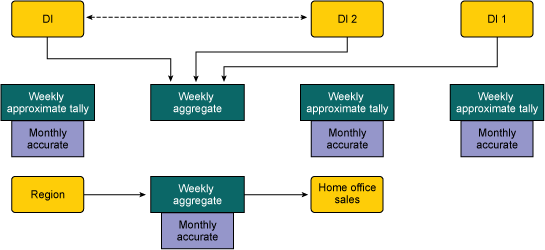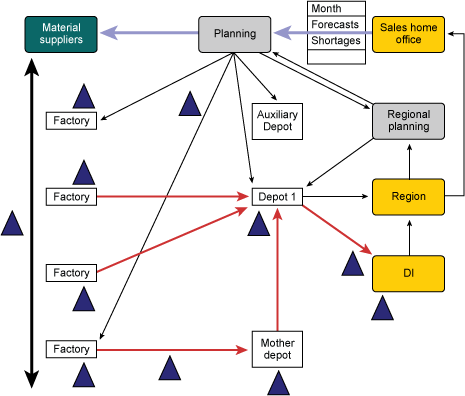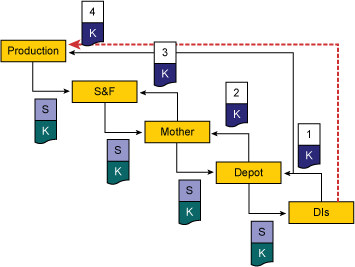
The “Great Indian Bazaar” – the rapidly growing and evolving Indian retail market – presents special and daunting distribution challenges for fast-moving consumer goods (FMCG) products, such as groceries, toiletries and other items that are used up and must be replaced in a short amount of time. For a typical producer, about 100 stock keeping units (SKUs, or product types) flow from 40 to 50 depots to 2,000 to 3,000 distributors, and then on to more than 1 million retail outlets, varying in size from the tiniest corner shop to large supermarkets.
Depending upon the product and the company’s manufacturing strategy, production could be sourced from a handful to as many as 50-plus plants spread throughout the country. Inevitably, not all plants produce all the products. At the end of the supply chain, every organization attempts to minimize product shortages and stock outs. The effort described here is aimed at improvements in availability of finished goods stocks.
The project in this case study used total quality management (TQM) concepts such as just-in-time, value stream mapping, eliminating non-value-added steps and initiating demand pull supply in the flow in order to help transform the supply chain. The effort used these principles within the structure of TQM’s seven steps of problem solving (similar to DMAIC [Define, Measure, Analyze, Improve, Control]), shown below:
Step 1: Define problem
Step 2: Find root causes
Step 3: Generate countermeasure ideas
Step 4: Test model
Step 5: Check results
Step 6: Implement in regular operation
Step 7: Prepare quality improvement story
Step 8: Repetitive practice of standard operating procedures (SOPs)
The model was developed in the Western region of the company. The supply chain was divided in to three “loops” – 1) depot to distributor, 2) factory to depot and 3) production. This case study is in three parts, each part dealing with one loop; the depot to distributor process is covered here in Part 1.
Step 1: Defining the Problem
To begin improving the depot to distributor process, a cross-functional team was assembled (sales, operations, planning, materials, IT) from the corporate and regional offices. After completing a two-day quality mindset training program, the team began the project.
They started by defining the availability problem. In TQM, a problem is defined as the desired state minus the current status. In this case, the desired state is 100 percent availability, or all SKUs present at all distributors (DI) on all days (A100).
For stock outs (or unavailability), the team suggested using this metric: 1 SKU stocked out for 1 day at 1 DI = 1 DISKUDay. Likewise, 2 SKUs stocked out for 2 days at 2 DIs = 2*2*2 DISKUDays. Therefore, the percentage of stock outs = the number of DISKUDays in a month*100/A100. For perfect availability, DISKUDays must = 0.
Data for the daily stock outs at each retail outlet was unavailable. Therefore, the team could not determine the current status. However, to create some quantification of the problem, a crude value stream map for material flow was compiled for end-of-month status across the region (Figure 1).

Total stock: 39 + approximately 14 (i.e., more than 50 a day)
Key: Triangle = stock (days) points, square = stock (days), S&F = factories
The problems exposed were:
- Heavy supply push to meet end-of-month sales targets
- Overstocking at DIs
The operating team confirmed this analysis.
Part 1 of the project introduced the concept of demand pull from depot to DI. The metric selected was reduction in weekly skew in sales during the month. The team decided to pilot the demand pull process in nine distributors that get products from one depot in the region. A careful measurement of supply to distributors (primary sales) and supply from distributors to retail outlets (secondary sales) was made. The results are shown in Table 1.
Table 1: Sales Measurements
| Week | Ideal % Sales | Secondary Sales % | Primary Sales % |
| 1 | 23 | 17 | 6 |
| 2 | 23 | 25 | 12 |
| 3 | 23 | 21 | 24 |
| 4 | 23 | 23 | 27 |
The goal of the project was to reduce the primary sales skew (supply push) from 30 percent to 10 percent in the last 3 days of the month.
Step 2: Find the Root Causes
To help find the root causes of the problem, the team constructed value stream maps of the current state (Figures 2 and 3).


The root causes of the problem were apparent:
- Information of actual sales was not available until a week after the month ended, and it was therefore of little use in planning supply.
- Production planning was based upon a forecast, because the system had to meet what they believed the demand would be 50 days later
Step 3: Generate Countermeasure Ideas
The countermeasure was clearly a demand-pull system, which would include the following features:
- Quick sales information flow from DIs
- Supply to demand – replenish stock
- Agreement on maximum stock levels (norms) for each DI for each SKU
- Shortest possible replenishment cycle to minimize maximum stock levels while ensuring minimum stock outs
The team also made a future-state map to incorporate these changes (Figure 4). Each stage gives its demand (Kanban) to its supplier, who supplies as per demand.

Key: K = Kanban (i.e., demand), S = Supply
While in principle this setup is very simple, getting it to work in practice involves very fundamental changes in mindsets across the supply chain (including 500 DIs, sales, logistics and factory management).
The first step in breaking the mindsets was a series of meetings to help the team internalize the concepts through specially designed training sessions and four computer games, followed by a pilot.
Step 4: Test the Ideas
The team began the pilot at nine DIs and one depot. The steps followed were:
- Identify depot and DIs
- Train personnel
- Develop an IT program to keep track of stock at the DIs and calculate the demand based upon stock norms and available stock
- Design system in detail:
-Calculate average sales per day of each DI over the last 3 months for each SKU
-Determine feasible truck sizes for delivery and maximum stock replenishment frequency feasible
-Agree on stock norms to be maintained at DIs (these were at least 50 percent lower than the averages measured)
-Most importantly, develop the formats and IT system to generate demand for each dispatch easily on the computer
-Develop a pull tracker where the daily stock level compared to the agreed norm is plotted. If the tracker shows stock going above stock norm, action can be taken to stop the supply push.
-Bring stocks down to norms – much more difficult than one would imagine, as company results were based on primary sales and this one-time correction amounts to a loss of sales.
Keeping in mind that disbelief that the concepts would work was widespread, intense discussions were required at each stage of the process. It took six months to simply get the pilot started.
Compared to a stock norm of 4,800 cartons, the stocks were at 20,000 at the end of July. Savage de-stocking in August followed by tight monitoring and troubleshooting over six months gradually made the system work.
December to March saw stock levels averaging at 70 percent of the norm, with some minor topping up still happening at the end of the month.
Step 5: Check the Result
Table 2 shows the change after the pilot project.
Table 2: Sales Measurements After Pilot
| Secondary Sales % Post-improvement | Primary Sales % Post-improvement | Primary Sales % Pre-improvement | |
| Week 1 | 20.6 | 20.9 | 6 |
| Week 2 | 25.1 | 28.9 | 12 |
| Week 3 | 23.4 | 24.0 | 24 |
| Week 4 | 23.3 | 27.7 | 27 |
| Days 29 to 30 | 7.6 | 8.5 | 30 |
The skew had virtually been eliminated – primary sales were less than 1 percentage point different than secondary sales in the last 3 days of the month. Simultaneously, the variations in day-to-day sales reduced.
Supply was now clearly operating in the demand-pull mode. What was particularly heartening was the response from the distributors – “Stock levels are down and supply is even and as per demand.”
Steps 6 and 7: Implement Across System and Document Results
After the pilot, the system was implemented across the region’s 12 depots and 200 major DIs in the next six months. Numerous local implementation problems were doggedly overcome.
A quality improvement story was prepared and presented to management. Based on this project, the organization eventually decided to extend this model countrywide. A model (covered in Part 2 and Part 3 of this case study) for a demand-pull system in the upstream links of the supply chain also was developed.